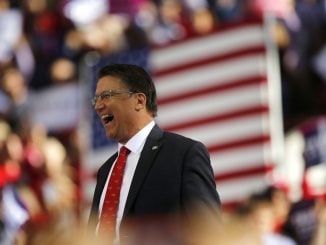RALEIGH For those who frequent the state legislative building for business, the silence of drilling and removal of scaffolding this week will be a welcomed sound. For Paul Coble, chief legislative services officer at the General Assembly, the end of the multimillion dollar project that he didn’t anticipate tackling just one year into the job is a bit nerve-wracking.”If we have any leaks when this is all done, I might just pack up my stuff and quietly leave,” Coble joked. Coble was hired to the legislative branch in August 2015, having previously served as mayor of Raleigh from 1999-2001 and more recently as a Wake County commissioner. The following month, lawmakers would include $9 million in the state budget for renovations on the building he would manage.”When they hired me that was not one of the job duties,” Coble said, “but like an onion, my job duties have been revealed over time.”The project was a long time coming, with leaks manifesting years ago.”I would be in the gallery and water would be running down the columns, soaking the rug below,” Coble said, describing incidents in the House chamber after he started.The history of the State Legislative Building began in January 1963, when the General Assembly relocated from the Old Capitol Building on Edenton Street. The structure was designed specifically to house the expanding legislative branch by American architect Edward Durell Stone, who notably designed structures such as the Kennedy Center, Radio City Music Hall and New York’s Museum of Modern Art. The building cost approximately $5 million to erect.As time elapsed, there was general wear and tear on the building, but it has also hit road bumps with innovation. Anyone who works in or visits the “LB” knows that you can’t rely on the Wi-Fi or expect to see Fox News running on a TV in a staffer’s office like when you visit Washington, D.C.”The Wi-Fi is so weak that I often can’t check email, don’t get notices if a committee has moved to another room, and miss correspondence from legislators and clients,” said one young lobbyist. “It hampers my ability to perform everyday duties.”Coble said the 1960s building was simply not built with Wi-Fi or cable access in mind and because of that and the volume of traffic, they often run into limitations.”Every time we update, the bandwidth keeps getting eaten up,” he said. “I don’t know if we’ll ever overcome it completely especially when everyone that walks in here has three devices.”Construction began in August, with the goal of restoring the building to its former glory before lawmakers adjourned for the 2017 long session. Replacing cracked pavement squares around the complex was one of the first and ultimately most time-consuming tasks, while work on the custom roof was the most dire and intricate.And like any construction project, renovations encountered a few hiccups.”Weather and two special sessions in December were intrusive on the roof project,” explained Coble. “Hurricane Matthew slowed us down, but didn’t really damage anything we just lost work days.”Either way, the early months required extra precaution as the material of choice for ceiling tiles in the 1960s was asbestos. Coble says they spent $900,000 alone on asbestos remediation, including daily air quality monitoring to ensure staff and visitors were safe.In November, the old copper roof was peeled back and sold for scrap. The technique required to remove the copper made the old panels impractical to reuse, dissimilar to most other elements in the building. Teams took great care removing gigantic glass windows and working around brass chandeliers, because almost everything at 16 West Jones St. is custom-made and expensive to replace. Rumor has it that the medium-sized disco ball-esque lights that hang from in the third floor lobby cost $15,000 a piece. And the teams from Owens Roofing, Raymond Engineering, Clear Sites Industrial and the State Construction Office did a pretty good job only cracking one glass panel in the process.As scaffolding comes down, the project appears to have come in under budget, using only about $5.1 million of the $9 million allocated a testament to the supervision of Coble, who also credits Safran Law Firm and Charles Weathersby, the facilities and maintenance officer at the General Assembly.”The tendency is to stay away from fixing government buildings. Critics will say that money is better spent somewhere else … but you can’t have a functioning government if everyone is sitting at their desks with an umbrella,” cracked Coble.
Related Articles

Article
Trump to nominate ex-congressman to lead international aid agency
WASHINGTON, May 10 (Reuters) – President Donald Trump will nominate former congressman Mark Green to head the U.S. Agency for International Development, the White House said in a statement on Wednesday. Green is a former […]

Article
Trump revokes Washington Posts campaign press credentials
WASHINGTON – Republican Donald Trump said on Monday he will no longer issue press credentials to the Washington Post, stopping the publication from gaining access to press areas at his presidential campaign events. His next […]

Article
McCrory looks toward the future
CHARLOTTE At Tuesday’s Rotary Club meeting in Charlotte, former Gov. Pat McCrory was honored with the Excellence in Leadership Award. The Rotarian honor recognizes excellence in industry and public service leaders with high ethical […]
